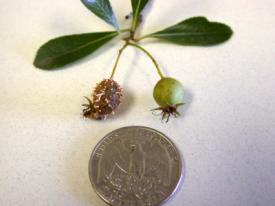

Cedar-quince rust aecia on hawthorn fruit.
|
|
| Severity: | 3.5 out of 5 |
| Frequency: | 4 out of 5 |
| Symptoms: | On evergreen hosts, infection occurs on needles and new shoots. In contrast to cedar-apple and cedar-hawthorn rust, this rust causes flaky, perennial branch swellings rather than distinct, roundish galls. Most of these swellings girdle and kill small twigs, but some survive and remain infectious for many years. Most people do not notice the branch swellings until the telia become wet, swell and gelatinize to a bright orange color. On deciduous hosts, leaves, petioles, young branches and fruit are usually infected and symptoms vary widely among the various hosts. On hawthorn, the pinkish aecia (tubes) occur mainly on branches, thorns, and fruit. Hawthorn and serviceberry fruit often becomes heavily covered with aecia. Branch and thorn infections result in spindle-shaped, perennial cankers that expand each growing season. However, most infected branches are girdled by the canker during the second season, causing die-back to a bud or side-shoot. |
| Cycle: | From the telial swellings on the evergreen host, basidiospores are released that infect deciduous hosts such as hawthorn. Seven to ten days after infection, spots or swellings develop, followed a few days later by the formation of tiny black dots (spermagonia) within the spots. Four to seven weeks later, aecia are formed. Aeciospores, released from the aecia during rain or as morning humidity lowers, become airborne and infect susceptible evergreen hosts during late summer and fall. The following spring (or one year later), swellings (consisting of both fungal and host plant tissues) develop on the evergreen host. When the swellings are mature, a few hours of wet, cool (74 to78 F is optimal) spring weather is sufficient for repeated telial swelling and release basidiospores that infect the deciduous host. In contrast to cedar-apple rust galls, cedar-quince rust swellings may remain infectious for 4-6 years or more. |
| Management: | Grow resistant varieties. Even though sanitation is not perfect, follow good cultural practices and remove as much of the infected twigs, fruit and leaves as possible. While separation of the alternate hosts is often recommended, spores from the elongated galls on juniper can move a quarter of a mile or more to infect the broadleaf host, so separation is not always possible. Protection of the broadleaf host with fungicide sprays is warranted if this disease is a chronic problem on high-value trees. To protect twigs and fruit, fungicides are applied as flower buds begin to open and continued 1 to 2 weeks past petal fall. |
| Associated trees: | |